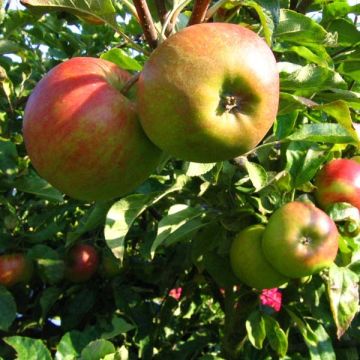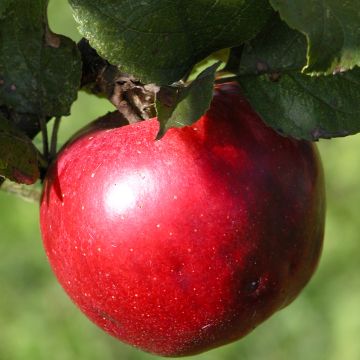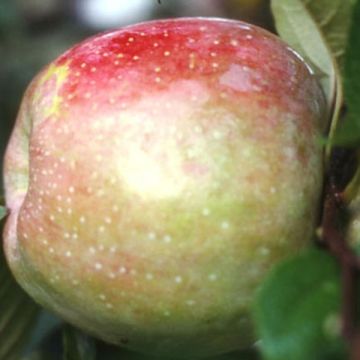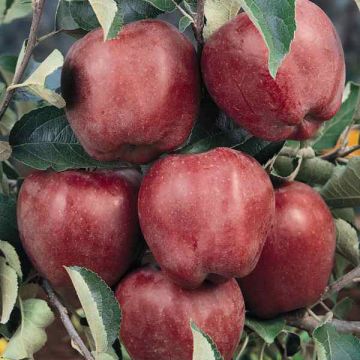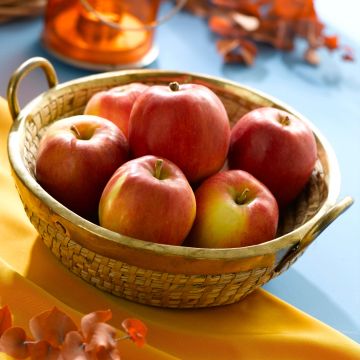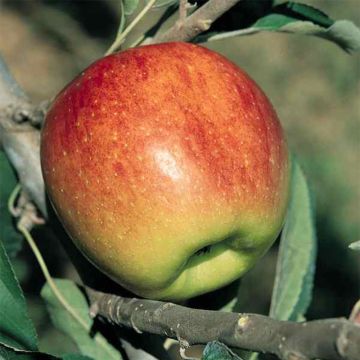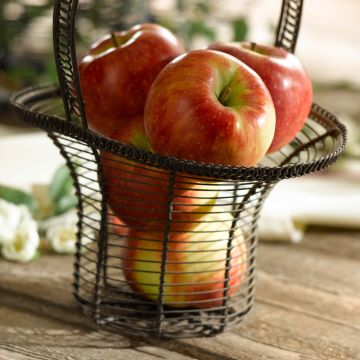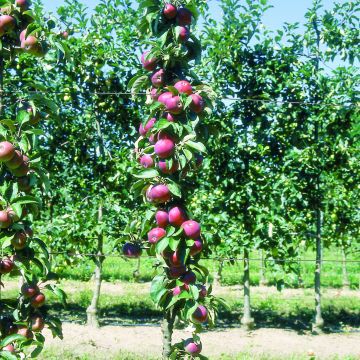

Apple Tree Golden Delicious - Malus domestica
Malus domestica Golden Delicious
Golden Delicious apple
Arrived in good condition The tree appears healthy.
Marilyn Dubois, 12/09/2016
Special offer!
Receive a €20 voucher for any order over €90 (excluding delivery costs, credit notes, and plastic-free options)!
1- Add your favorite plants to your cart.
2- Once you have reached €90, confirm your order (you can even choose the delivery date!).
3- As soon as your order is shipped, you will receive an email containing your voucher code, valid for 3 months (90 days).
Your voucher is unique and can only be used once, for any order with a minimum value of €20, excluding delivery costs.
Can be combined with other current offers, non-divisible and non-refundable.
Home or relay delivery (depending on size and destination)
Schedule delivery date,
and select date in basket
This plant carries a 6 months recovery warranty
More information
We guarantee the quality of our plants for a full growing cycle, and will replace at our expense any plant that fails to recover under normal climatic and planting conditions.

Description
Malus domestica 'Golden Delicious' is a productive variety, producing apples with golden yellow skin and fine, juicy flesh, both sweet and slightly tart. It is a good eating apple and can also be cooked in desserts or served with savoury dishes. It bears fruit quickly and regularly. In order to ensure good pollination, this self-fertile variety needs to be associated with a King of the Pippins, Granny Smith, Starking Delicious, or Melrose apple tree, within a radius of 20 m to 30 m (66 ft to 98.4 ft). It is a very good pollinator. Planting is preferably done in autumn or spring for a harvest starting in autumn.
'Golden Delicious' produces medium-sized apples with golden yellow skin. The flesh, which is fine, crisp, and juicy, has a good balance, being both sweet and slightly tart. The apple can be eaten raw or cooked, in compotes, pastries, or as an accompaniment to savoury dishes such as black pudding, pork, or in salads. The harvest of Golden Delicious starts in autumn. Only keep the fruits picked from the tree. The apple can be stored with the stem facing downward, on racks or in crates. Choose a preferably completely dark, dry, cool place, but frost-free. The apples will keep for several months, until the following spring.
The 'Golden Delicious' variety, one of the most well-known, is an American variety dating back to 1890. The flowering starts in early April, with flowers that are white-pink in colour, with 5 petals. It is a very good pollinator, helping to fruit other apple trees of different varieties that are nearby. For its own fruiting, it requires the proximity of another pollinator apple tree, within a radius of 20 m to 30 m (66 ft to 98.4 ft), such as King of the Pippins, Granny Smith, Starking Delicious, or Melrose. Indeed, like many apple trees, this variety is only slightly self-fertile.
The apple tree belongs to the Rosaceae family and the genus Malus. It is a tree with a semi-erect habit, with good frost resistance, able to withstand up to -30° C (-22° F). Easy to grow, it is suitable for orchards but can also find its place in the garden, isolated on a short grass meadow or at the back of a border, thanks to its highly ornamental spring flowering. The 'Golden Delicious' Apple tree is a variety of medium to strong vigour and will reach a height of 4 m to 5 m (13.1 ft to 16.4 ft) with a similar width.
Plant habit
Fruit
Flowering
Foliage
Botanical data
Malus
domestica
Golden Delicious
Rosaceae
Golden Delicious apple
North America
Other Apple trees
View all →Planting and care
Choose a sunny location, ideally sheltered. The soil can be slightly chalky or acidic but not excessively. Loosen the soil deeply, remove rocks and unwanted weeds. Add some sand to improve drainage. Dig a wide planting hole at least 3 times the size of the root ball. Make sure to separate the bottom soil from the topsoil. Mix fertiliser and organic matter (potting soil, compost) with the bottom soil and pour this mixture into the planting hole. Place the root ball, cover with the topsoil without burying the grafting collar and firm it down. Water generously (about 10L). You can stake the apple tree by installing a guy wire system: plant 3 stakes in a triangle shape about 50 cm (19.7 in) around the trunk and connect them with pieces of wood. Protect the bark with a piece of rubber, for example, and attach the stakes to the trunk with metal wires.
Fruit trees are ideally planted between October and March, outside the freezing period. Container-grown plants can be planted all year round except during periods of extreme heat or frost.
Every year, in autumn, apply well-rotted compost on the surface. In winter, add a small handful of wood ash, rich in potash; this will improve fruiting. Hoe if necessary at the base of the tree.
Apple trees can be subject to various diseases and pests. In order to limit risks, space the trees sufficiently, install multi-species hedges, birdhouses or insect hotels to attract beneficial insects. In case of disease, remove and burn all affected parts.
The main diseases of the apple tree are scab (brown spots on the leaves), brown rot (wilting of the flowers and rotting of the fruits on the tree) and powdery mildew (white powdery coating on the leaves), for which it is possible to treat with fungicide sprays in cases of severe infestation. As for pests, the codling moth or fruit worm, a small caterpillar, can be controlled by installing birdhouses and bat boxes and by placing corrugated cardboard strips along the trunk. In case of aphid infestation, spray a solution based on black soap.
Planting period
Intended location
Care
Planting & care advice
-
, onOrder confirmed
Reply from on Promesse de fleurs
Haven't found what you were looking for?
Hardiness is the lowest winter temperature a plant can endure without suffering serious damage or even dying. However, hardiness is affected by location (a sheltered area, such as a patio), protection (winter cover) and soil type (hardiness is improved by well-drained soil).

Photo Sharing Terms & Conditions
In order to encourage gardeners to interact and share their experiences, Promesse de fleurs offers various media enabling content to be uploaded onto its Site - in particular via the ‘Photo sharing’ module.
The User agrees to refrain from:
- Posting any content that is illegal, prejudicial, insulting, racist, inciteful to hatred, revisionist, contrary to public decency, that infringes on privacy or on the privacy rights of third parties, in particular the publicity rights of persons and goods, intellectual property rights, or the right to privacy.
- Submitting content on behalf of a third party;
- Impersonate the identity of a third party and/or publish any personal information about a third party;
In general, the User undertakes to refrain from any unethical behaviour.
All Content (in particular text, comments, files, images, photos, videos, creative works, etc.), which may be subject to property or intellectual property rights, image or other private rights, shall remain the property of the User, subject to the limited rights granted by the terms of the licence granted by Promesse de fleurs as stated below. Users are at liberty to publish or not to publish such Content on the Site, notably via the ‘Photo Sharing’ facility, and accept that this Content shall be made public and freely accessible, notably on the Internet.
Users further acknowledge, undertake to have ,and guarantee that they hold all necessary rights and permissions to publish such material on the Site, in particular with regard to the legislation in force pertaining to any privacy, property, intellectual property, image, or contractual rights, or rights of any other nature. By publishing such Content on the Site, Users acknowledge accepting full liability as publishers of the Content within the meaning of the law, and grant Promesse de fleurs, free of charge, an inclusive, worldwide licence for the said Content for the entire duration of its publication, including all reproduction, representation, up/downloading, displaying, performing, transmission, and storage rights.
Users also grant permission for their name to be linked to the Content and accept that this link may not always be made available.
By engaging in posting material, Users consent to their Content becoming automatically accessible on the Internet, in particular on other sites and/or blogs and/or web pages of the Promesse de fleurs site, including in particular social pages and the Promesse de fleurs catalogue.
Users may secure the removal of entrusted content free of charge by issuing a simple request via our contact form.
The flowering period indicated on our website applies to countries and regions located in USDA zone 8 (France, the United Kingdom, Ireland, the Netherlands, etc.)
It will vary according to where you live:
- In zones 9 to 10 (Italy, Spain, Greece, etc.), flowering will occur about 2 to 4 weeks earlier.
- In zones 6 to 7 (Germany, Poland, Slovenia, and lower mountainous regions), flowering will be delayed by 2 to 3 weeks.
- In zone 5 (Central Europe, Scandinavia), blooming will be delayed by 3 to 5 weeks.
In temperate climates, pruning of spring-flowering shrubs (forsythia, spireas, etc.) should be done just after flowering.
Pruning of summer-flowering shrubs (Indian Lilac, Perovskia, etc.) can be done in winter or spring.
In cold regions as well as with frost-sensitive plants, avoid pruning too early when severe frosts may still occur.
The planting period indicated on our website applies to countries and regions located in USDA zone 8 (France, United Kingdom, Ireland, Netherlands).
It will vary according to where you live:
- In Mediterranean zones (Marseille, Madrid, Milan, etc.), autumn and winter are the best planting periods.
- In continental zones (Strasbourg, Munich, Vienna, etc.), delay planting by 2 to 3 weeks in spring and bring it forward by 2 to 4 weeks in autumn.
- In mountainous regions (the Alps, Pyrenees, Carpathians, etc.), it is best to plant in late spring (May-June) or late summer (August-September).
The harvesting period indicated on our website applies to countries and regions in USDA zone 8 (France, England, Ireland, the Netherlands).
In colder areas (Scandinavia, Poland, Austria...) fruit and vegetable harvests are likely to be delayed by 3-4 weeks.
In warmer areas (Italy, Spain, Greece, etc.), harvesting will probably take place earlier, depending on weather conditions.
The sowing periods indicated on our website apply to countries and regions within USDA Zone 8 (France, UK, Ireland, Netherlands).
In colder areas (Scandinavia, Poland, Austria...), delay any outdoor sowing by 3-4 weeks, or sow under glass.
In warmer climes (Italy, Spain, Greece, etc.), bring outdoor sowing forward by a few weeks.

































